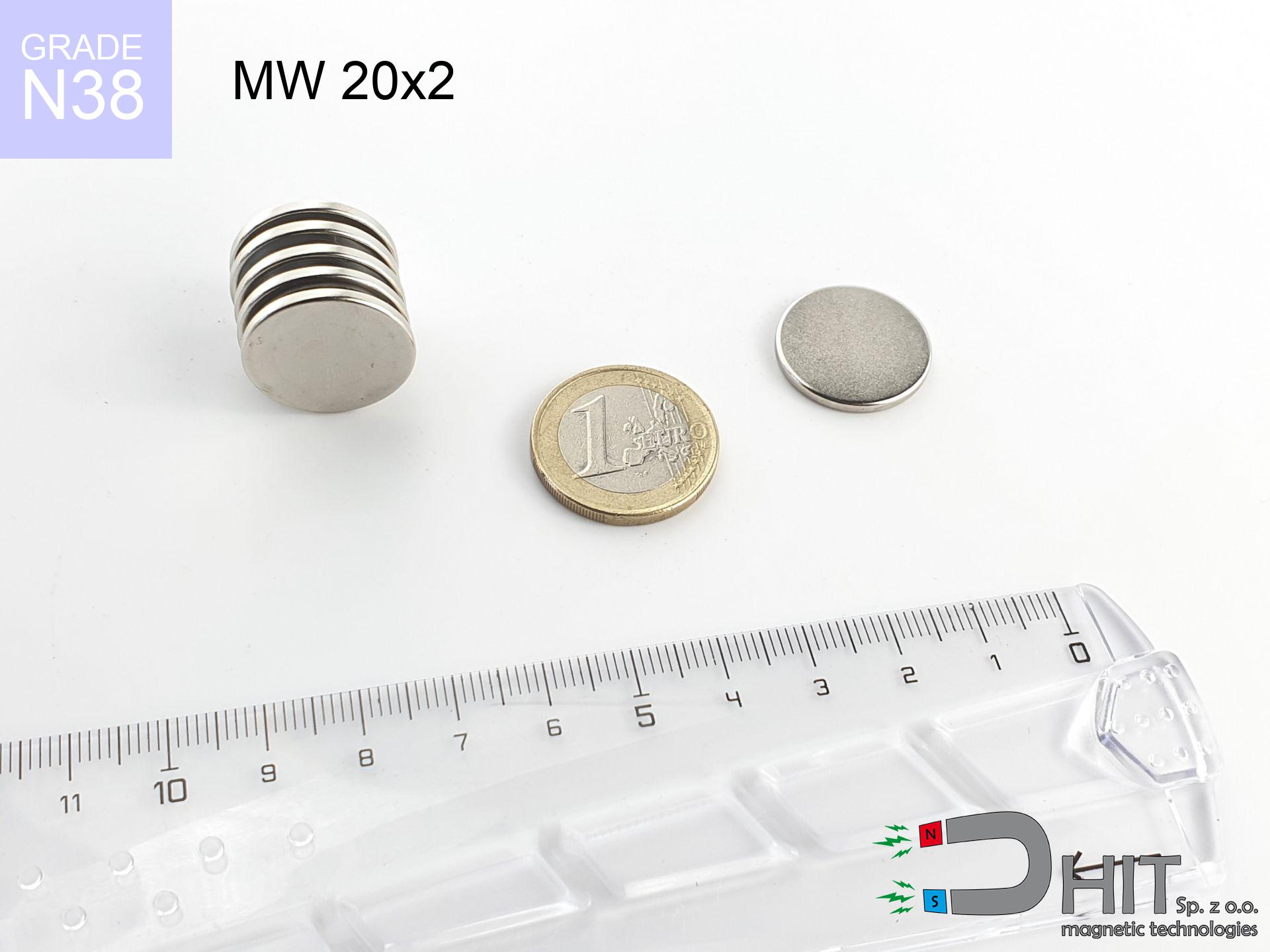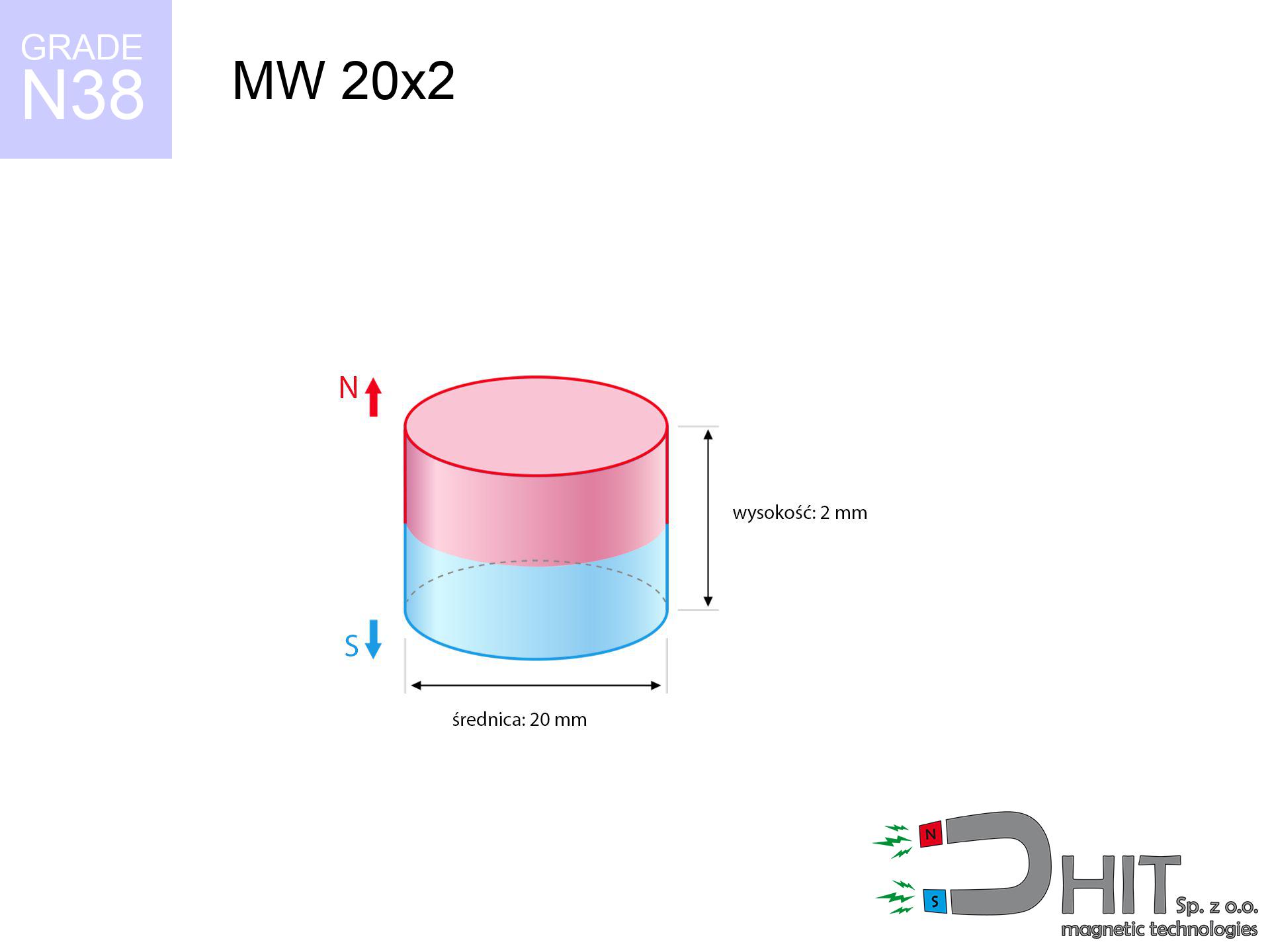MW 20x2 / N38 - cylindrical magnet
cylindrical magnet
Catalog no 010041
GTIN: 5906301810407
Diameter Ø [±0,1 mm]
20 mm
Height [±0,1 mm]
2 mm
Weight
4.71 g
Magnetization Direction
↑ axial
Load capacity
2.21 kg / 21.67 N
Magnetic Induction
121.57 mT
Coating
[NiCuNi] nickel
2.08 ZŁ with VAT / pcs + price for transport
1.690 ZŁ net + 23% VAT / pcs
1.650 ZŁ net was the lowest price in the last 30 days
bulk discounts:
Need more?Looking for a better price?
Call us
+48 888 99 98 98
alternatively let us know via
contact form
the contact form page.
Weight along with structure of a magnet can be reviewed using our
magnetic calculator.
Orders placed before 14:00 will be shipped the same business day.
Magnetic properties of material N38
Physical properties of sintered neodymium magnets Nd2Fe14B at 20°C
Shopping tips
Advantages and disadvantages of neodymium magnets.
Besides their remarkable pulling force, neodymium magnets offer the following advantages:
- They do not lose magnetism, even during nearly ten years – the drop in power is only ~1% (according to tests),
- They are resistant to demagnetization induced by external field influence,
- The use of an elegant layer of noble metals (nickel, gold, silver) causes the element to be more visually attractive,
- The surface of neodymium magnets generates a unique magnetic field – this is one of their assets,
- Due to their durability and thermal resistance, neodymium magnets are capable of operate (depending on the shape) even at high temperatures reaching 230°C or more...
- Thanks to versatility in forming and the capacity to customize to unusual requirements,
- Universal use in modern technologies – they are utilized in computer drives, motor assemblies, medical equipment, also multitasking production systems.
- Compactness – despite small sizes they generate large force, making them ideal for precision applications
Characteristics of disadvantages of neodymium magnets: tips and applications.
- At very strong impacts they can break, therefore we advise placing them in steel cases. A metal housing provides additional protection against damage and increases the magnet's durability.
- We warn that neodymium magnets can lose their strength at high temperatures. To prevent this, we advise our specialized [AH] magnets, which work effectively even at 230°C.
- Magnets exposed to a humid environment can corrode. Therefore during using outdoors, we recommend using waterproof magnets made of rubber, plastic or other material resistant to moisture
- Limited ability of producing nuts in the magnet and complex forms - preferred is casing - magnet mounting.
- Possible danger related to microscopic parts of magnets pose a threat, when accidentally swallowed, which becomes key in the context of child safety. Furthermore, tiny parts of these products are able to be problematic in diagnostics medical after entering the body.
- With budget limitations the cost of neodymium magnets is economically unviable,
Maximum magnetic pulling force – what contributes to it?
The force parameter is a theoretical maximum value conducted under standard conditions:
- on a base made of mild steel, perfectly concentrating the magnetic flux
- possessing a massiveness of minimum 10 mm to avoid saturation
- with an polished touching surface
- without any clearance between the magnet and steel
- during pulling in a direction perpendicular to the plane
- at ambient temperature approx. 20 degrees Celsius
Lifting capacity in real conditions – factors
Real force is affected by working environment parameters, such as (from most important):
- Gap between magnet and steel – every millimeter of separation (caused e.g. by veneer or dirt) drastically reduces the magnet efficiency, often by half at just 0.5 mm.
- Loading method – catalog parameter refers to pulling vertically. When applying parallel force, the magnet holds much less (typically approx. 20-30% of maximum force).
- Wall thickness – thin material does not allow full use of the magnet. Magnetic flux penetrates through instead of generating force.
- Steel type – mild steel attracts best. Alloy admixtures lower magnetic properties and holding force.
- Surface finish – ideal contact is obtained only on polished steel. Any scratches and bumps reduce the real contact area, weakening the magnet.
- Thermal environment – heating the magnet causes a temporary drop of induction. Check the maximum operating temperature for a given model.
* Holding force was tested on a smooth steel plate of 20 mm thickness, when the force acted perpendicularly, however under shearing force the lifting capacity is smaller. Additionally, even a slight gap {between} the magnet and the plate lowers the load capacity.
Safe handling of NdFeB magnets
Metal Allergy
Certain individuals experience a contact allergy to nickel, which is the typical protective layer for NdFeB magnets. Extended handling might lead to a rash. It is best to use safety gloves.
Phone sensors
An intense magnetic field interferes with the functioning of magnetometers in phones and GPS navigation. Keep magnets close to a device to prevent breaking the sensors.
Pinching danger
Pinching hazard: The attraction force is so immense that it can result in hematomas, crushing, and even bone fractures. Use thick gloves.
Safe distance
Intense magnetic fields can destroy records on payment cards, hard drives, and storage devices. Maintain a gap of min. 10 cm.
Thermal limits
Keep cool. NdFeB magnets are susceptible to heat. If you require operation above 80°C, ask us about special high-temperature series (H, SH, UH).
Pacemakers
For implant holders: Powerful magnets disrupt medical devices. Maintain minimum 30 cm distance or ask another person to work with the magnets.
Fragile material
Despite the nickel coating, the material is delicate and not impact-resistant. Avoid impacts, as the magnet may shatter into sharp, dangerous pieces.
Caution required
Use magnets with awareness. Their immense force can surprise even experienced users. Plan your moves and do not underestimate their power.
Choking Hazard
Always keep magnets away from children. Choking hazard is significant, and the consequences of magnets clamping inside the body are fatal.
Machining danger
Mechanical processing of neodymium magnets carries a risk of fire hazard. Magnetic powder oxidizes rapidly with oxygen and is hard to extinguish.
Important!
Details about risks in the article: Magnet Safety Guide.





![SM 25x200 [2xM8] / N52 - magnetic separator SM 25x200 [2xM8] / N52 - magnetic separator](https://cdn3.dhit.pl/graphics/products/sm-25x200-2xm8-jas.jpg)
![UMP 135x40 [M10+M12] GW F 600 kg / N38 - search holder UMP 135x40 [M10+M12] GW F 600 kg / N38 - search holder](https://cdn3.dhit.pl/graphics/products/ump135x40-m10+m12-gw-f-600-kg-luz.jpg)


